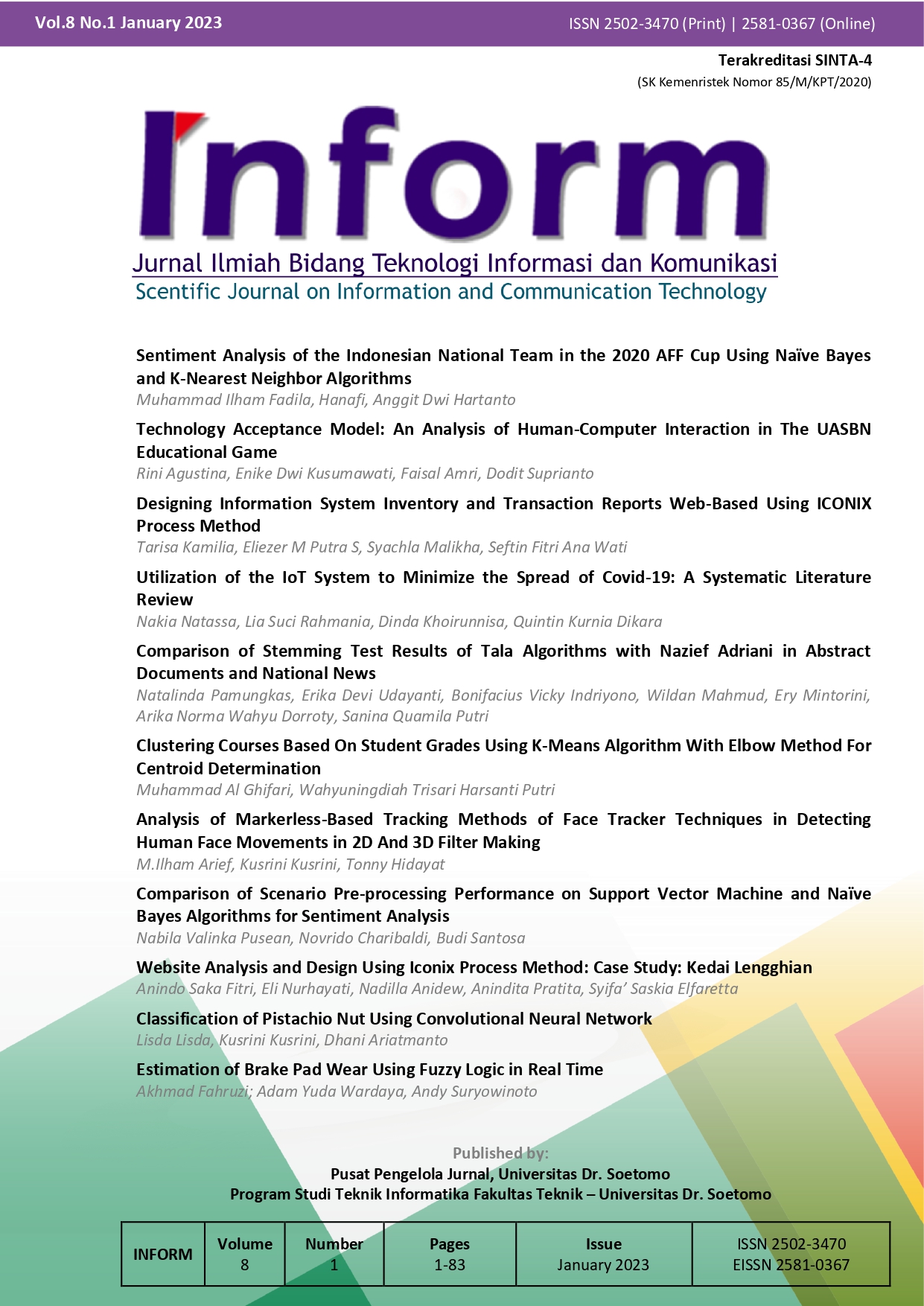Clustering Courses Based On Student Grades Using K-Means Algorithm With Elbow Method For Centroid Determination
 Abstract views: 451
,
Abstract views: 451
,
 PDF downloads: 344
PDF downloads: 344
Abstract
Students who have taken courses will receive grades from a performance index with a weight of 0 to 4. The amount of historical student data, particularly on course grades, has the potential to discover new insights. Still, course grades are closed data and are only for academic and management purposes. The research aims to a grouping of courses with high average grades. In this research, the clustering of courses using the k-means clustering algorithm using the elbow method to determine the centroid. Based on the Sum of Squares calculation, the optimal number of clusters with k=2 was obtained. The clustering results produced cluster 1 with a centroid value of 2.686 and 15 members and cluster 2 with a centroid value of 3.245 and 40 members. It can be concluded from this research that the members of cluster 2 are a group of courses with high average grades.
References
Lester H. Hunt, Grade Inflation: Academic Standards in Higher Education. SUNY Press, 2008.
V. N. Budiyasari, P. Studi, T. Informatika, F. Teknik, U. Nusantara, and P. Kediri, “Implementasi Data Mining Pada Penjualan kacamata Dengan Menggunakan Algoritma Apriori,” Indones. J. Comput. Inf. Technol., vol. 2, no. 2, pp. 31–39, 2017.
R. S. J. Baker, "Data Mining for Education," Encycl. Data Warehous. Min., 2011, doi: 10.4018/978-1-59140-557-3.
J. He, "Advances in data mining: History and future," 3rd Int. Symp. Intell. Inf. Technol. Appl. IITA 2009, vol. 1, pp. 634–636, 2009, doi: 10.1109/IITA.2009.204.
F. Coenen, "Data mining: Past, present and future," Knowl. Eng. Rev., vol. 26, no. 1, pp. 25–29, 2011, doi: 10.1017/S0269888910000378.
K. P. Sinaga and M. S. Yang, "Unsupervised K-means clustering algorithm," IEEE Access, vol. 8, pp. 80716–80727, 2020, doi: 10.1109/ACCESS.2020.2988796.
M. Z. Rodriguez et al., Clustering algorithms: A comparative approach, vol. 14, no. 1. 2019. doi: 10.1371/journal.pone.0210236.
F. Yunita, “Penerapan Data Mining Menggunkan Algoritma K-Means Clustring Pada Penerimaan Mahasiswa Baru,” Sistemasi, vol. 7, no. 3, p. 238, 2018, doi: 10.32520/stmsi.v7i3.388.
J. J. Manoharan, S. H. Ganesh, M. L. P. Felciah, and A. K. S. Banu, "Discovering students' academic performance based on GPA using K-means clustering algorithm," Proc. - 2014 World Congr. Comput. Commun. Technol. WCCCT 2014, pp. 200–202, 2014, doi: 10.1109/WCCCT.2014.75.
I. Arwani, “Integrasi Algoritma K-Means Dengan Bahasa SQL Untuk Klasterisasi IPK Mahasiswa (Studi Kasus: Fakultas Ilmu Komputer Universitas Brawijaya),” J. Teknol. Inf. dan Ilmu Komput., vol. 2, no. 2, p. 143, 2015, doi: 10.25126/jtiik.201522148.
Y. E. Fadrial, “Klasterisasi Hasil Evaluasi Akademik Menggunakan Metode K-Means (Studi Kasus Fakultas Ilmu Komputer UNILAK),” Semin. Nas. Teknol. Inf. Ilmu Komput., vol. 1, no. 1, pp. 53–65, 2020.
A. E. Rahayu, K. Hikmah, N. Yustia, and A. C. Fauzan, “Penerapan K-Means Clustering Untuk Penentuan Klasterisasi Beasiswa Bidikmisi Mahasiswa,” Ilk. J. Comput. Sci. Appl. Informatics, vol. 1, no. 2, pp. 82–86, 2019, doi: 10.28926/ilkomnika.v1i2.23.
P. Bholowalia and A. Kumar, "EBK-Means: A Clustering Technique based on Elbow Method and K-Means in WSN," Int. J. Comput. Appl., vol. 105, no. 9, pp. 975–8887, 2014.
M. A. Syakur, B. K. Khotimah, E. M. S. Rochman, and B. D. Satoto, "Integration K-Means Clustering Method and Elbow Method for Identification of the Best Customer Profile Cluster," IOP Conf. Ser. Mater. Sci. Eng., vol. 336, no. 1, 2018, doi: 10.1088/1757-899X/336/1/012017.
D. Marutho, S. Hendra Handaka, E. Wijaya, and Muljono, "The Determination of Cluster Number at k-Mean Using Elbow Method and Purity Evaluation on Headline News," Proc. - 2018 Int. Semin. Appl. Technol. Inf. Commun. Creat. Technol. Hum. Life, iSemantic 2018, pp. 533–538, 2018, doi: 10.1109/ISEMANTIC.2018.8549751.
H. Islam and M. Haque, "An Approach of Improving Student's Academic Performance by using K-means clustering algorithm and Decision tree," Int. J. Adv. Comput. Sci. Appl., vol. 3, no. 8, pp. 146–149, 2012, doi: 10.14569/ijacsa.2012.030824.
D. Xu and Y. Tian, "A Comprehensive Survey of Clustering Algorithms," Ann. Data Sci., vol. 2, no. 2, pp. 165–193, 2015, doi: 10.1007/s40745-015-0040-1.
T. Kanungo, D. M. Mount., N. Netanyahu, C. D. Piatko, R. Silverman, and A. Y. Wu, "An Efficient k-Means Clustering Algorithm: Analysis and Implementation," Am. J. Clin. Nutr., vol. 56, no. 2, pp. 385–393, 1992, doi: 10.1093/ajcn/56.2.385.
D. Arthur and S. Vassilvitskii, "How Slow is the k-Means method ? General Terms :," Construction, pp. 144–153, 2006.
F. Pedregosa et al., "Scikit-learn: Machine Learning in Python," Environ. Health Perspect., vol. 127, no. 9, pp. 2825–2830, 2019, doi: 10.1289/EHP4713.
L. Buitinck et al., "API design for machine learning software: experiences from the scikit-learn project," pp. 1–15, 2013, [Online]. Available: http://arxiv.org/abs/1309.0238
Copyright (c) 2023 Muhammad Al Ghifari, Wahyuningdiah Trisari Harsanti Putri

This work is licensed under a Creative Commons Attribution-ShareAlike 4.0 International License.
Authors who publish with Inform: Jurnal Ilmiah Bidang Teknologi Informasi dan Komunikasi agree to the following terms:
-
Authors retain copyright and grant the journal right of first publication with the work simultaneously licensed under a Creative Commons Attribution License (CC BY-SA 4.0) that allows others to share the work with an acknowledgment of the work's authorship and initial publication in this journal.
-
Authors are able to enter into separate, additional contractual arrangements for the non-exclusive distribution of the journal's published version of the work (e.g., post it to an institutional repository or publish it in a book), with an acknowledgment of its initial publication in this journal.
-
Authors are permitted and encouraged to post their work online (e.g., in institutional repositories or on their website) prior to and during the submission process, as it can lead to productive exchanges, as well as earlier and greater citation of published work.













